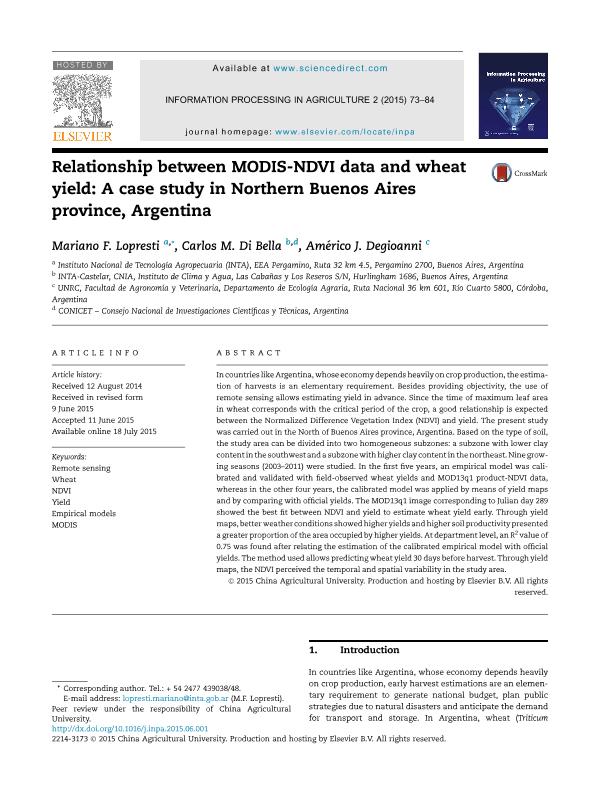Mostrar el registro sencillo del ítem
dc.contributor.author
Lopresti, Mariano F.
dc.contributor.author
Di Bella, Carlos Marcelo

dc.contributor.author
Degioanni, Americo

dc.date.available
2018-08-17T16:49:17Z
dc.date.issued
2015-09
dc.identifier.citation
Lopresti, Mariano F.; Di Bella, Carlos Marcelo; Degioanni, Americo; Relationship between MODIS-NDVI data and wheat yield: A case study in Northern Buenos Aires province, Argentina; China Agricultural University; Information Processing in Agriculture; 2; 2; 9-2015; 73-84
dc.identifier.issn
2214-3173
dc.identifier.uri
http://hdl.handle.net/11336/56173
dc.description.abstract
In countries like Argentina, whose economy depends heavily on crop production, the estimation of harvests is an elementary requirement. Besides providing objectivity, the use of remote sensing allows estimating yield in advance. Since the time of maximum leaf area in wheat corresponds with the critical period of the crop, a good relationship is expected between the Normalized Difference Vegetation Index (NDVI) and yield. The present study was carried out in the North of Buenos Aires province, Argentina. Based on the type of soil, the study area can be divided into two homogeneous subzones: a subzone with lower clay content in the southwest and a subzone with higher clay content in the northeast. Nine growing seasons (2003–2011) were studied. In the first five years, an empirical model was calibrated and validated with field-observed wheat yields and MOD13q1 product-NDVI data, whereas in the other four years, the calibrated model was applied by means of yield maps and by comparing with official yields. The MOD13q1 image corresponding to Julian day 289 showed the best fit between NDVI and yield to estimate wheat yield early. Through yield maps, better weather conditions showed higher yields and higher soil productivity presented a greater proportion of the area occupied by higher yields. At department level, an R2 value of 0.75 was found after relating the estimation of the calibrated empirical model with official yields. The method used allows predicting wheat yield 30 days before harvest. Through yield maps, the NDVI perceived the temporal and spatial variability in the study area.
dc.format
application/pdf
dc.language.iso
eng
dc.publisher
China Agricultural University
dc.rights
info:eu-repo/semantics/openAccess
dc.rights.uri
https://creativecommons.org/licenses/by-nc-nd/2.5/ar/
dc.subject
Empirical Models
dc.subject
Modis
dc.subject
Ndvi
dc.subject
Remote Sensing
dc.subject
Wheat
dc.subject
Yield
dc.subject.classification
Agricultura

dc.subject.classification
Agricultura, Silvicultura y Pesca

dc.subject.classification
CIENCIAS AGRÍCOLAS

dc.title
Relationship between MODIS-NDVI data and wheat yield: A case study in Northern Buenos Aires province, Argentina
dc.type
info:eu-repo/semantics/article
dc.type
info:ar-repo/semantics/artículo
dc.type
info:eu-repo/semantics/publishedVersion
dc.date.updated
2018-08-16T18:07:42Z
dc.journal.volume
2
dc.journal.number
2
dc.journal.pagination
73-84
dc.journal.pais
China
dc.description.fil
Fil: Lopresti, Mariano F.. Instituto Nacional de Tecnología Agropecuaria. Centro Regional Buenos Aires Norte. Estación Experimental Agropecuaria Pergamino; Argentina
dc.description.fil
Fil: Di Bella, Carlos Marcelo. Consejo Nacional de Investigaciones Científicas y Técnicas; Argentina. Instituto Nacional de Tecnología Agropecuaria. Centro de Investigación de Recursos Naturales. Instituto de Clima y Agua; Argentina
dc.description.fil
Fil: Degioanni, Americo. Universidad Nacional de Rio Cuarto. Facultad de Agronomia y Veterinaria. Departamento de Ecología Agraria; Argentina
dc.journal.title
Information Processing in Agriculture
dc.relation.alternativeid
info:eu-repo/semantics/altIdentifier/doi/https://dx.doi.org/10.1016/j.inpa.2015.06.001
dc.relation.alternativeid
info:eu-repo/semantics/altIdentifier/url/https://www.sciencedirect.com/science/article/pii/S221431731500027X
Archivos asociados
